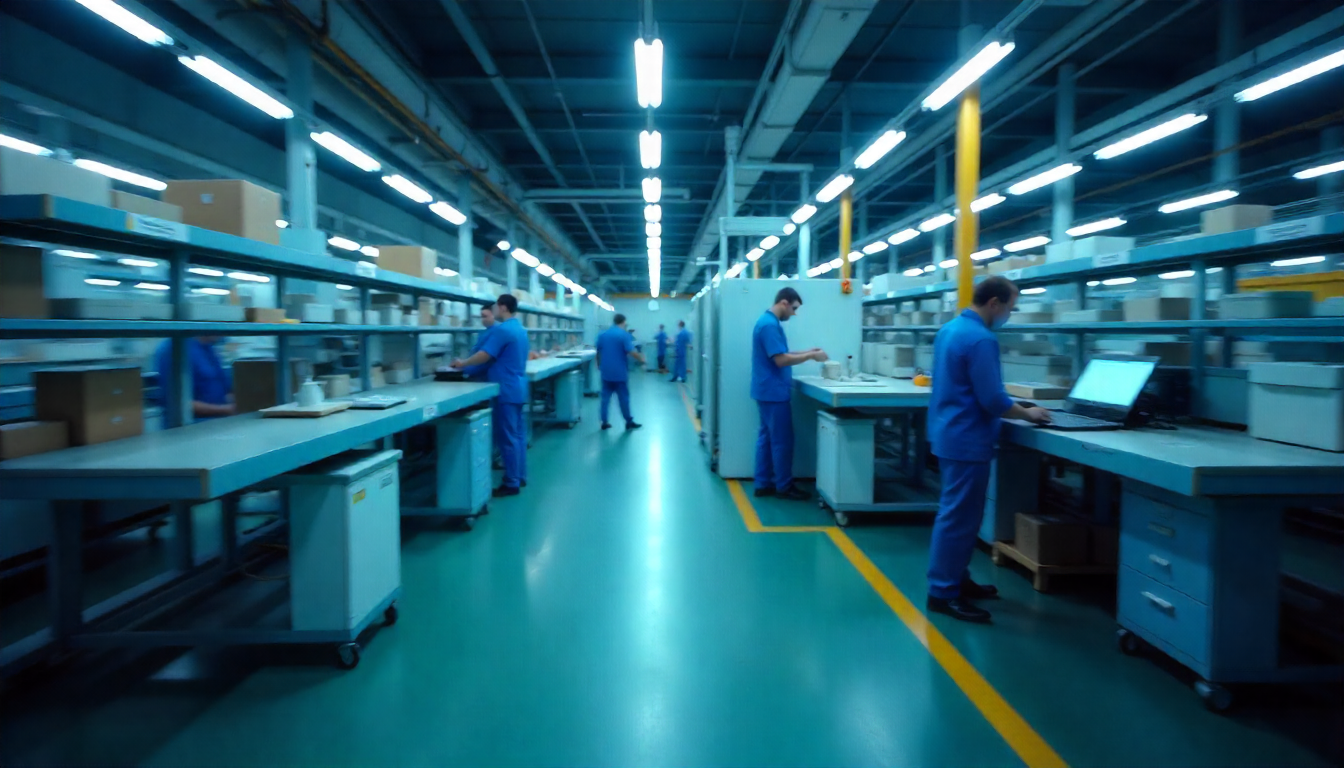Table of Contents
- Production Report – Definition and Scope
- Production Reporting – From Manual Methods to Full Automation
- Manual Production In Reporting
- Partially Digitalized Reporting
- Digitalized and Automated Production Reporting
- Production Reporting – Why Full Digitalization Matters
- What Should a Production Report Include?
- KPIs in Production Reporting
- Statistical Process Control (SPC) and Production Reporting
- How Production Report Support Business Decision-Making
- Benefits of Automated Production Reporting
Production reporting is the process of systematically recording and tracking the progress of manufacturing operations. It involves monitoring key aspects such as task completion rates, material consumption, output volumes, and quality statuses. As a cornerstone of modern production management, it provides objective data needed to verify whether operations are proceeding according to plan, on schedule, and in compliance with required standards.
Through production reports, managers gain detailed insight into shop floor performance, enabling them to assess schedule adherence, analyze efficiency, and fully leverage available production capacity.
A well-designed reporting system translates raw technical data into clear, actionable business information, forming the basis for informed decision-making.
What should a complete production report include? Why is automation in this process so critical to maintaining competitiveness? And what does advanced production reporting look like in MES-class systems, such as the Production Portal? These are the questions this article will explore.
Production Report – Definition and Scope
A production report is a formalized document that details and summarizes the key metrics measured throughout the manufacturing process. Its purpose is to provide the information necessary to maximize production efficiency, identify waste, and optimize workflows.
The formats of such reports vary widely—from simple spreadsheet tables to advanced, interactive dashboards in modern MES systems, such as the Production Portal, which make data analysis and visualization more accessible.
Production Reporting – From Manual Methods to Full Automation
The method of production reporting in a given company depends on its scale, industry, level of technological advancement, and the specifics of the processes being monitored. However, due to its cyclical nature—and the significant business benefits it delivers—production reporting is one of the areas most frequently and effectively digitized. From a technological standpoint, we can distinguish several core approaches.
Manual Production Reporting
Manual reporting relies on traditional, paper-based documentation or simple tools such as spreadsheets (e.g., Excel). Operators record key data by hand, such as the number of units produced, working hours, or raw material consumption. This method is typically used in smaller facilities or in operations with low complexity.
- Advantages: Low initial cost as well as ease and speed of implementation.
- Disadvantages: The main drawbacks include a high risk of human error when entering data, no real-time visibility into processes, and difficulties in aggregating and analyzing information from multiple sources. It is easy to imagine a machine operator at the end of a long day, tired and filling out a report by hand. Mistakes in such a scenario are almost inevitable. In addition, the frequency of data submission is so low that making accurate business decisions in real time becomes virtually impossible. This approach significantly hinders the ability to respond quickly to changes or potential issues.
Partially Digitalized Reporting
This is a hybrid model in which companies use basic software or spreadsheets—for instance, to track material consumption—while production processes and shop floor progress are still recorded manually. It is a popular solution that often serves as a stepping stone toward full digitalization, blending elements of both worlds.

Digitalized and Automated Production Reporting
The most advanced approach to production reporting is full digitalization and automation of the process, typically implemented through MES (Manufacturing Execution System) platforms. These systems integrate directly with shop floor machines and equipment, enabling not only automatic data collection but also instant analysis and seamless integration with other business processes.
MES systems rely on diverse, often combined methods of data acquisition to ensure completeness and accuracy. This model is built on three primary sources:
1. Operator Reporting – Production Terminals (HMI/MES)
Operators enter information via terminals located at workstations or directly into the MES platform. This applies especially to data that machines cannot capture on their own, such as:
- reasons for unplanned downtime,
- the number of defective units (NOK) along with defect causes,
- setup times or delays caused by organizational factors.
The data is immediately stored in a central database, linked to the relevant order, machine, and operator, and made available in real time to all departments (planning, logistics, maintenance, and management).
Although the entry itself is manual, the output is fully digitalized—the information becomes part of an integrated ecosystem rather than a “dead” Excel file. Sometimes this approach is intentionally chosen when low process frequency makes full automation economically unjustifiable. Before investing in digitalization and automation, it is therefore advisable to conduct an audit and seek expert technology consulting.
2. IIoT Devices and PLC/SCADA Integration
The second pillar of digital reporting is data collected automatically from machines and their environment. In practice, this includes two complementary approaches:
- Direct integration with machine automation (PLC/SCADA):
This forms the backbone of fully automated reporting. The MES connects directly to PLC controllers or SCADA systems, retrieving real-time process data such as cycle times, output counts, operating statuses (running/downtime/failure), alarms, and technological parameters (e.g., temperature, pressure, speed). - IIoT sensors and devices:
Particularly useful with older machines lacking modern PLC controllers, or when additional measurements are required. External sensors can track parameters such as energy consumption, vibrations, temperature, or humidity. The data is transmitted wirelessly to the MES, effectively “digitalizing” even legacy production assets.
Leveraging these data sources, the system can:
- automatically generate failure alerts,
- schedule preventive maintenance,
- optimize production flow,
- provide real-time analysis based on a complete dataset.
3. Traceability and Quality Control Systems
The third area covers technologies for tracking material flow and ensuring product quality:
- Barcode and 2D code scanning systems (QR, Data Matrix):
These enable component and order tracking across production stages, automatically update statuses in the system, and provide full traceability—for example, linking a finished product to its material batch and the responsible operator. Such solutions are widely used in industries with strict quality requirements, such as pharmaceuticals, automotive, and food manufacturing. - Machine vision systems:
Cameras equipped with image analysis software perform automated quality control. They can detect product defects, verify assembly accuracy, or read markings, with the results (OK/NOK) instantly transferred to the MES.
Production Reporting – Why Full Digitalization Matters
Integrating the above methods within a single system makes it possible to achieve a consistent and reliable real-time view of production. The data requires no additional “processing,” flows instantly to all departments, and can automatically trigger subsequent processes—from order placement and schedule adjustments to the generation of quality reports.
Unlike partially digitalized models, here the information is “alive” and actively supports both operational and strategic decision-making.
Digitalization and automation of reporting significantly reduce the number of errors and virtually eliminate the time spent on manual data entry. As a result, companies gain information that is both fully reliable and always up to date—something practically unattainable in manual systems based solely on employee declarations.
What Should a Production Report Include?
The scope of information contained in a production report can vary widely depending on the specific needs of a manufacturing facility and the nature of its processes. Such a document may focus on selected parameters or provide a comprehensive dataset offering a complete picture of the production workflow.
Production Reporting – Example Data Points
- Basic Data:
- Finished goods count: Total number of products meeting quality standards.
- Production output: Measured within defined time frames (e.g., per shift, per day, per production batch).
- Order statuses: Progress of production orders and their alignment with the schedule.
- Machine and Process Data:
- Machine performance: OEE (Overall Equipment Effectiveness) metrics.
- Process parameters: Data such as temperature, pressure, or torque, critical for ensuring quality.
- Tool usage: Identification of tools used during production.
- Quality and Material Data:
- Work-in-progress (WIP): Quantity of unfinished products.
- Quality control indicators: Inspection results, number of OK/NOK items, and reasons for rejection.
- Raw material traceability: Information enabling tracking of a product’s path from raw material to finished good.
- Operational Data:
- Production order number: Links data to a specific order.
- Operator and workstation IDs: Allow responsibility assignment and performance analysis at the operator or cell level.
- Production date and time: Precise timestamps for each operation.

KPIs in Production Reporting
Production reports are more than just collections of data—they are essential tools for calculating key performance indicators (KPIs). The choice of which KPIs to monitor should always be driven by the company’s strategic business goals.
Examples of Production KPIs:
- Overall Equipment Effectiveness (OEE): Measures how effectively equipment is utilized. OEE combines availability, performance, and quality into a single percentage, offering a comprehensive view of machine productivity.
- Capacity utilization: Tracks the percentage of total production capacity that is actually being used, helping assess whether resources are maximized.
- Downtime: The amount of time machines are idle due to failures, maintenance, material shortages, or changeovers.
- Cycle time: The time required to produce a single unit, from start to finish of an operation.
- First Pass Yield (FPY): The percentage of products manufactured correctly the first time, without rework—an immediate indicator of process quality.
- Scrap rate: The amount of material wasted during production. Used alongside FPY, it provides a clearer picture of material efficiency.
Statistical Process Control (SPC) and Production Reporting
Reporting systems often integrate Statistical Process Control (SPC) modules. SPC applies statistical methods to monitor and control the production process in real time.
An SPC report is the output of such a module, which analyzes whether key process parameters (e.g., dimensions, weight, temperature) remain within defined tolerance limits. Its greatest strength lies in prevention—if the system detects that indicators are approaching or exceeding thresholds, it can automatically trigger an alert or even halt production. This approach helps avoid issues before they occur, such as producing an entire batch of defective products. SPC reports are generated automatically and can be distributed via email, enabling immediate response and rapid corrective action.
How Production Report Support Business Decision-Making
The primary value of production reporting lies in transforming raw but reliable, up-to-date technical data into actionable business insights. Access to this information facilitates long-term planning and strategic decision-making, such as:
- Performance management: Reports allow objective evaluation of individual machines or production lines.
- Bottleneck identification: Reports pinpoint exactly where workflow slows down or stalls, enabling managers to implement improvements that boost throughput and shorten lead times.
- Cost optimization: Analysis of utility consumption (energy, water) and scrap levels helps identify unnecessary cost drivers. Data on the root causes of defective products (NOK) enables rapid elimination of problem sources.
- Improved forecasting: Historical report data supports more accurate predictions of future raw material and component demand. This helps optimize inventory levels, avoiding both shortages and excess stockpiling.

Benefits of Automated Production Reporting
Implementing a well-designed, automated reporting system delivers numerous benefits that directly enhance the safety, competitiveness, and profitability of a manufacturing company. Key advantages include:
- Better production planning and forecasting: Real-time data enables more accurate performance predictions, capacity planning, and production scheduling.
- Enhanced decision support: Up-to-date, reliable information simplifies decisions regarding investments, equipment modernization, and process improvements.
- Improved maintenance efficiency: Automatic detection of deviations and failure alerts support the shift from reactive to preventive maintenance. Continuous reporting also helps identify patterns leading to unplanned downtime and pinpoint their root causes.
- Regulatory and standards compliance: Electronic records of all production events simplify reporting for audits, quality standards (ISO, IATF), and legal requirements.
- Facilitated continuous improvement (Kaizen/Lean): Accurate data highlights waste and provides a solid foundation for process optimization.
- Reduced non-conformance: Real-time alerts on process deviations minimize the number of defective products.
- Enhanced traceability: Automated reporting creates a digital record of a product’s entire history, serving as the foundation for full traceability.
- Standardized communication: Reports provide a shared, objective source of information across departments, fostering collaboration and reducing misunderstandings.
- Lower administrative costs: Automation eliminates the need for manual report preparation, data re-entry, and paper archiving—saving both time and resources.
- Greater production flexibility: Fast access to data allows dynamic responses to changes in orders, priorities, and production schedules.
Production reporting is no longer just a formal requirement or stacks of paper in binders. It has become a critical tool for effective manufacturing management. At the core of successful reporting lies data that is reliable, up to date, and available in real time.
The transition from manual methods to automated data collection and analysis is now a key step toward Industry 4.0, enabling companies to transform raw data into actionable insights. Such insights drive continuous improvement, reduce costs, and empower better business decision-making.


